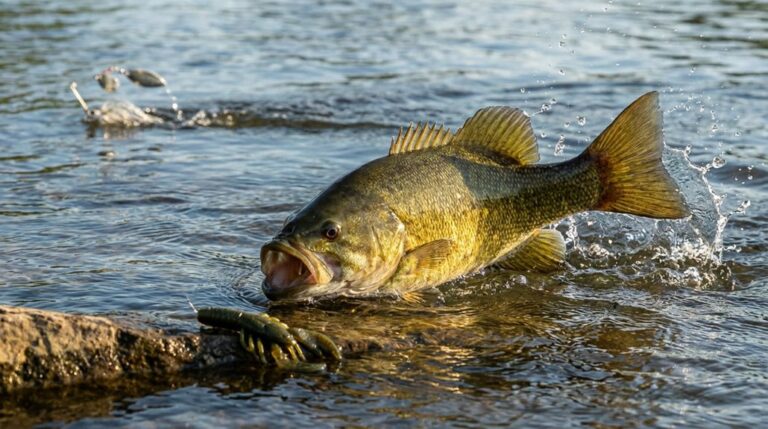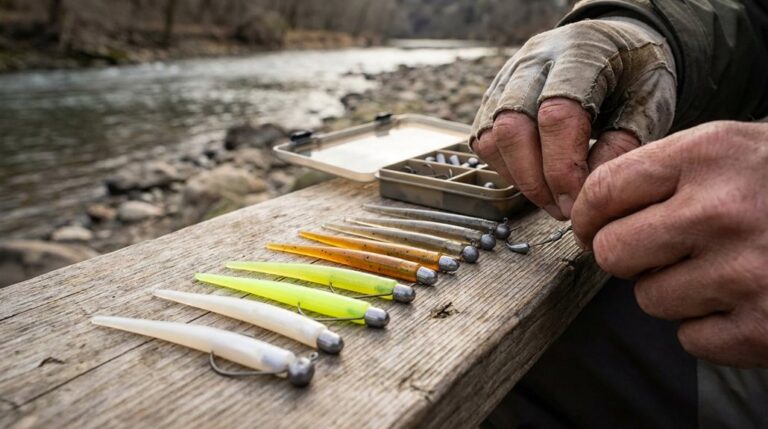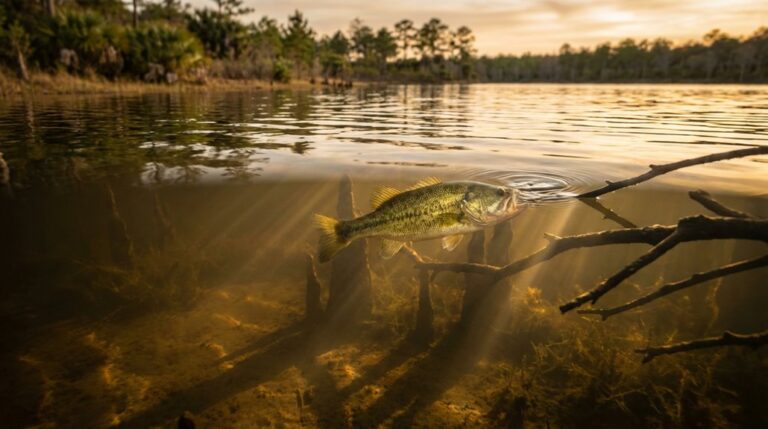You'll find smallmouth bass thriving in clear, cool waters between 67-71°F with rocky or gravelly bottoms. They prefer depths of 1-15 feet and need oxygen levels of at least 5 ppm for active feeding. During spawning, they seek shallow areas with sand or gravel substrates in temperatures of 55-65°F. Look for them near structural elements like rocks and submerged logs where their favorite prey, like crawfish, gather. Understanding these habitat preferences will boost your success on the water.
Essential Water Temperature Requirements
While smallmouth bass can survive in a wide range of temperatures, they're most active and feed heavily when water temperatures stay between 67° and 71°F.
You'll find these fish can adapt to warmer conditions in the 70s and low 80s during summer, but they'll often seek deeper waters to find more oxygen-rich environments.
When water temperature drops below 50°F, you'll notice these fish become sluggish, and they'll almost completely stop feeding once it dips under 40°F.
However, don't assume they're entirely inactive in cold water – research has shown they can still actively feed in near-freezing conditions at shallow depths.
You'll see that water temperature markedly influences where you'll find smallmouth bass, as they'll move throughout the water column to locate their preferred temperature zones.
Optimal Depth and Substrate Preferences
In addition to temperature preferences, depth and substrate choices play key roles in smallmouth bass behavior.
You'll find that smallmouth bass prefer nesting sites in relatively shallow waters, typically between 1 to 15 feet deep, where they can effectively guard their eggs and monitor surrounding conditions.
When it comes to bottom composition, these fish are quite selective. They seek out areas with gravel or sand substrates, particularly favoring spots where the material ranges from pea-sized gravel to small cobblestones.
Clear water is vital for their nesting success, as it promotes the growth of aquatic vegetation that provides significant cover for eggs and fry. This vegetation not only offers protection but also creates an ideal environment for the early development stages of young bass.
Dissolved Oxygen Levels and Fish Health

Dissolved oxygen levels play a critical role in determining smallmouth bass health and behavior.
You'll find these fish need at least 2.0 ppm of oxygen to survive, but they won't actively feed or grow until levels reach 5 ppm or higher.
During summer months, when deeper waters become oxygen-depleted, you'll notice smallmouth bass moving to shallower areas to find better-oxygenated conditions.
Rivers and streams with moving water naturally maintain higher oxygen levels, making them ideal habitats. The presence of aquatic plants further enhances oxygen availability in these environments.
Water body fertility also impacts oxygen content.
You'll discover healthier smallmouth bass populations in oligo- and mesotrophic lakes where oxygen levels remain stable, unlike eutrophic lakes that often suffer from oxygen depletion, potentially stressing or displacing the fish.
Critical Spawning Site Characteristics
Successful smallmouth bass reproduction depends heavily on specific spawning site characteristics.
You'll find these fish seeking out shallow waters between 1 to 15 feet deep, where they carefully select their nesting locations based on water clarity and bottom composition.
The ideal spawning habitat features gravel or sandy substrates, ranging from pea-sized particles to small cobblestones, which protect developing eggs and guarantee proper oxygen flow.
Water temperature plays a vital role, as smallmouth bass won't spawn until it reaches 55-65°F. They prefer clear water conditions that support protective vegetation, though extremely clear water may push them to nest deeper to avoid predators.
Watch out for human impacts like shoreline development and pollution, as these can destroy spawning grounds by covering suitable substrates with harmful sediment.
Structural Elements for Cover and Protection

Beyond spawning sites, structural elements provide smallmouth bass the shelter and ambush points they need throughout their lives. You'll find these fish gravitating toward rocky bottoms where they can easily hide and hunt. Unlike their largemouth cousins, smallmouth bass don't rely on thick vegetation for cover.
| Structure Type | Primary Benefits |
|---|---|
| Rocky Bottom | Feeding & Protection |
| Drop-offs | Ambush Points |
| Submerged Islands | Territory Marking |
When you're looking for smallmouth bass, focus on areas with diverse rock sizes and natural cover like logs and submerged objects. These features create the perfect environment for their ambush feeding strategy. The combination of varying depths, structural changes, and hard surfaces gives smallmouth bass everything they need to thrive, from protection against predators to prime hunting grounds.
Water Fertility Impact on Population Growth
Water fertility plays a crucial role in determining smallmouth bass population success, with these fish showing a clear preference for less fertile, oligotrophic waters.
You'll find that these low-nutrient environments provide ideal conditions for smallmouth bass growth and reproduction, thanks to their deep, clear waters and consistent oxygen levels.
When you look at more fertile lakes, you'll notice they're less suitable for smallmouth bass populations.
The higher nutrient content leads to increased organic matter decomposition, which depletes oxygen levels and restricts the fish's viable habitat.
In contrast, lakes with lower fertility offer these fish better spawning conditions and reduced competition from other species.
You'll see healthier smallmouth bass populations in these cleaner, less nutrient-rich environments where they can actively feed and thrive.
Seasonal Migration and Movement Patterns

As temperatures fluctuate throughout the year, smallmouth bass follow distinct migration patterns that reflect their need for ideal living conditions.
You'll find these fish adapting their depth preferences based on seasonal changes, with summer months driving them to waters at least 25 feet deep to escape warm temperatures and low oxygen levels.
During late spring to early summer, when waters reach 55 to 65°F, smallmouth bass move to shallower areas between 1 to 15 feet for spawning.
They're most active when temperatures hit their sweet spot of 67° to 71°F.
As fall approaches, they'll return to deeper waters, typically choosing areas with rocky or boulder-covered bottoms.
The clarity of the water and availability of suitable nesting substrates also influence where these fish choose to migrate throughout the seasons.
Food Source Availability and Distribution
The abundance and distribution of food sources strongly influence where you'll find smallmouth bass in any given water system. You'll notice these fish congregating in rocky areas where crawfish and other benthic organisms thrive. These locations serve as prime feeding grounds, especially during warmer months when prey activity peaks.
| Season | Primary Food Sources | Habitat Focus |
|---|---|---|
| Spring | Insects, Small Fish | Shallow Areas |
| Summer | Crawfish, Benthics | Rocky Points |
| Fall | Various Fish | Deep Structure |
The health of the water body plays a vital role in prey availability. While nutrient-rich environments support larger prey populations, you'll need to watch for signs of excessive nutrients that can lead to oxygen depletion. Clear, cool waters typically maintain the most balanced food distribution, supporting diverse prey species that smallmouth bass depend on. Additionally, the ideal water temperature for bass feeding ranges from 60-75°F, which can significantly impact their habitat preferences.
Water Quality Parameters and Survival

Maintaining specific water conditions proves vital for smallmouth bass survival and reproduction.
You'll find these fish thriving in oligotrophic waters where dissolved oxygen levels reach at least 2.0 ppm, though they need 5 ppm for ideal feeding and growth. They prefer temperatures between 67° to 71°F in clear, deep waters.
When summer causes oxygen depletion in deeper areas, smallmouth bass demonstrate remarkable adaptability by moving to shallower zones.
You'll notice they're particularly sensitive to environmental changes, as human activities that increase sedimentation and pollution can severely impact their habitat.
The water quality directly affects their ability to reproduce and maintain healthy populations.
To support smallmouth bass populations, it's important to protect their habitats from factors that could compromise oxygen levels and water clarity.
Habitat Competition With Other Species
While sharing ecosystems with various fish species, smallmouth bass engage in constant competition for resources and territory.
You'll find them competing most prominently with largemouth bass, though their distinct habitat preferences often lead to natural separation, with smallmouth bass favoring cooler, clearer waters and rocky areas.
When smallmouth bass enter new waters, they can greatly impact the existing ecosystem through:
- Aggressive territorial defense during spawning season
- Competition for limited food resources with native species
- Domination of deep, oxygen-rich environments in oligotrophic lakes
These habitat preferences and competitive behaviors make smallmouth bass particularly successful at establishing themselves in new environments.
In many cases, they'll outcompete local species, especially in waters that match their preferred conditions of clear, cool, and rocky substrates.
Frequently Asked Questions
What Is the Preferred Habitat of the Smallmouth Bass?
You'll find smallmouth bass thriving in cool, clear waters at least 25 feet deep with rocky bottoms. They prefer temperatures between 67-71°F, need 5 ppm oxygen, and choose gravel or sandy areas for nesting.
What Are the Best Conditions for Smallmouth Bass?
You'll find the best conditions when there's cool, clear water between 67-71°F, rocky bottoms at 25+ feet deep, and dissolved oxygen above 5 ppm. They'll also need shallow, gravelly areas for spawning.
Where Is the Best Place to Fish for Smallmouth Bass?
You'll find the best smallmouth bass fishing in cool, clear lakes with rocky bottoms at least 25 feet deep. Target areas near drop-offs, submerged islands, and natural cover where water temperatures reach 67-71°F.
Where Do Smallmouth Bass Like to Hang Out?
You'll find smallmouth bass hanging around rocky bottoms, deep pools, and boulder-strewn areas. They love places with fallen logs, drop-offs, and clear water where they can ambush prey near submerged structures.
Final Thoughts
You'll find smallmouth bass thrive in clear, cool waters between 65-75°F with rocky or gravel bottoms at depths of 3-30 feet. They need dissolved oxygen levels above 6 ppm and clean spawning beds. Success depends on finding areas with plenty of cover like logs, boulders, and vegetation. Track their seasonal movements and guarantee abundant food sources to maintain healthy populations.




